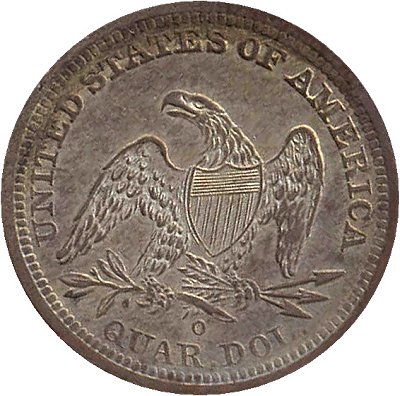

|
|
|
1843-O Liberty Seated Quarter Dollar - Polished Reverse Die
by Greg Johnson
It is with great enthusiasm that I begin what is planned as a monthly column regarding Liberty Seated Quarter die varieties. The intent is to offer a brief description, some photographs, and a few facts, opinions or stories regarding the monthly coin-of-interest. There are, literally, hundreds of coins to choose from. Seated quarter varieties cover the spectrum from merely scarce to excessively rare, from obscure to listed-in-the-red-book, and from immediately obvious to very subtle. It is an intriguing and nearly endless area for numismatic study.
The first Quarter of the Month is a rather obscure,
rare, and very interesting die pairing of the 1843-O. The feature one immediately
notices about this coin is the extremely polished reverse die (listed as reverse
E in Briggs’ The Complete Encyclopedia of United States Liberty Seated
Quarters). Note in the picture above the complete lack of tail feathers and
the missing feathers at the top of the eagle’s left wing. The first example
I located, several years ago, was a rather harshly cleaned example with uncirculated
details. Its initial appearance was so striking that I thought it was counterfeit;
it didn’t look like a seated quarter reverse at first glance. After determining
that it was indeed genuine, I considered purchasing the coin despite the significant
problem. The asking price persuaded me to pass. Over the past 3-4 years, while
diligently working on a die marriage set of ’43-O quarters, I have located
no more than six examples of this particular die pairing. Interestingly, all
six examples have had XF or better details. Back
to Quarter of Month Topic List 
This reverse die is easily identifiable, not only by the die polishing, but
also because of the unique mintmark position. There are six known reverse dies
for the ’43-O quarter – five small O and one large O. Amongst the
five small O reverses, one has the mintmark just right of the crotch between
feathers and olive branch, one is centered, two are very slightly left, and
the present reverse die (E) is the only one located completely to the left of
the crotch. The other four small O reverses all pair with Briggs’ obverse
1, reverse E pairs with Briggs’ obverse die 2 and is the only reverse
known to be paired with that obverse die. The distinctions between obverses
1 and 2 are subtle and will not be considered here. Though the sample size is
very small (six pieces) it also appears that, like many coins from highly polished
dies, this reverse generally comes proof-like in appearance.
The 1843-O quarter, as a date and mintmark, is a very scarce coin in high grade
or problem free condition. In addition to the usual problems such as harsh cleanings
and holes with which early seated coins are frequently found, the ’43-O
is also plagued with poor strikes, heavily rusted dies, and poor quality planchets.
It is interesting to note that reverse E, discussed and pictured here, does
not appear to have been used prior to being heavily polished. The unique mintmark
location would make attribution of such an early, pre-polishing, die state fairly
straightforward. One can speculate that since dies were made in Philadelphia
and shipped to New Orleans, this particular die most likely rusted quite heavily
prior to its first use in the coining process and was therefore polished prior
to that initial use.